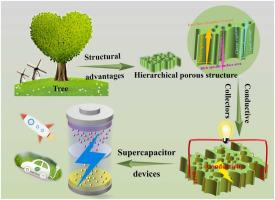当前位置:
X-MOL 学术
›
Ind. Crops Prod.
›
论文详情
Our official English website, www.x-mol.net, welcomes your feedback! (Note: you will need to create a separate account there.)
Regulation of wood porous structure and construction of reduced graphene oxide@wood derived carbon conducting collector
Industrial Crops and Products ( IF 5.6 ) Pub Date : 2024-06-26 , DOI: 10.1016/j.indcrop.2024.119069 Xiaofei Shan , Lili Li , Li Wang , Zhangjing Chen , Ximing Wang
Industrial Crops and Products ( IF 5.6 ) Pub Date : 2024-06-26 , DOI: 10.1016/j.indcrop.2024.119069 Xiaofei Shan , Lili Li , Li Wang , Zhangjing Chen , Ximing Wang

|
With the gradual increase in the consumption of non-renewable energy sources, the development of energy storage and conversion devices has become increasingly important. Sustainable self-supporting conductive collectors have become one of the effective ways to enhance the performance of energy storage devices. In this study, the pore modulation technique was implemented on Beijing poplar and camphor pine using delignification and water extraction, and six wood-derived carbon (WC) electrodes were prepared by heat treatment using untreated material as a control. By observing the microscopic morphology, it was found that all six carbon materials retained the graded porous structure characteristic of natural wood. The carbon material prepared from water extraction treated Beijing poplar (WPC) had the best capacitive properties. The conductive reduced graphene oxide (RGO) is composited with WPC, and the constructed RGO@WPC (RWPC) conductive collector has an average conductivity as high as 15.4 S m, which provides a strong guarantee for fast electron transport. The specific capacitance of RWPC is as high as 2100 mF cm when the current density is 1 mA cm. The constructed RWPC//RWPC energy storage device has a maximum energy density of 3.76 Wh kg and a maximum power density of 171.3 W kg. In this paper, a green and efficient self-supporting conductive collector with a graded porous structure is proposed. It also broadens the high value-added utilization of wood in energy storage.
更新日期:2024-06-26











































 京公网安备 11010802027423号
京公网安备 11010802027423号